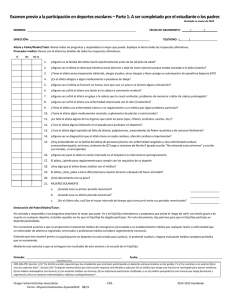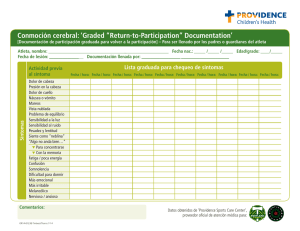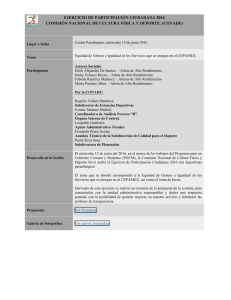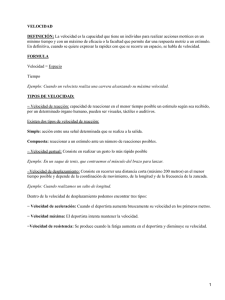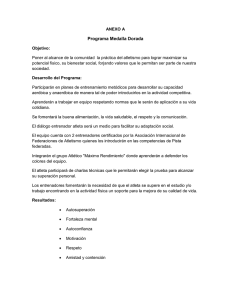Examen previo a la participación en deportes escolares
Anuncio
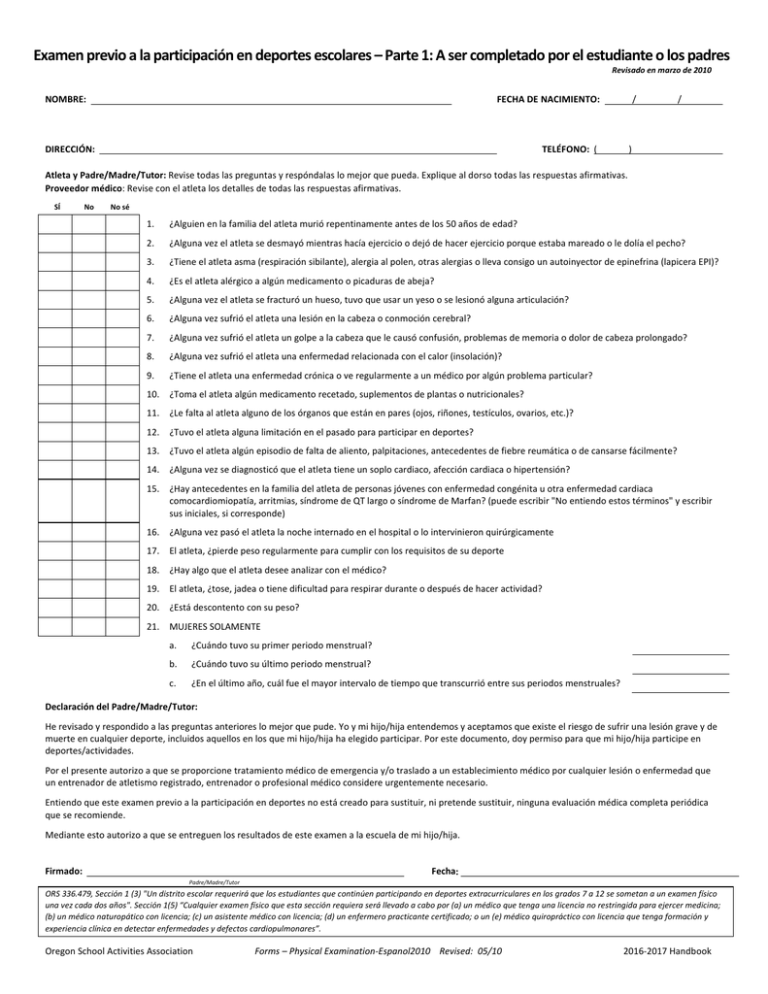
Examen previo a la participación en deportes escolares – Parte 1: A ser completado por el estudiante o los padres Revisado en marzo de 2010 NOMBRE: FECHA DE NACIMIENTO: / / DIRECCIÓN: TELÉFONO: ( ) Atleta y Padre/Madre/Tutor: Revise todas las preguntas y respóndalas lo mejor que pueda. Explique al dorso todas las respuestas afirmativas. Proveedor médico: Revise con el atleta los detalles de todas las respuestas afirmativas. SÍ No No sé 1. ¿Alguien en la familia del atleta murió repentinamente antes de los 50 años de edad? 2. ¿Alguna vez el atleta se desmayó mientras hacía ejercicio o dejó de hacer ejercicio porque estaba mareado o le dolía el pecho? 3. ¿Tiene el atleta asma (respiración sibilante), alergia al polen, otras alergias o lleva consigo un autoinyector de epinefrina (lapicera EPI)? 4. ¿Es el atleta alérgico a algún medicamento o picaduras de abeja? 5. ¿Alguna vez el atleta se fracturó un hueso, tuvo que usar un yeso o se lesionó alguna articulación? 6. ¿Alguna vez sufrió el atleta una lesión en la cabeza o conmoción cerebral? 7. ¿Alguna vez sufrió el atleta un golpe a la cabeza que le causó confusión, problemas de memoria o dolor de cabeza prolongado? 8. ¿Alguna vez sufrió el atleta una enfermedad relacionada con el calor (insolación)? 9. ¿Tiene el atleta una enfermedad crónica o ve regularmente a un médico por algún problema particular? 10. ¿Toma el atleta algún medicamento recetado, suplementos de plantas o nutricionales? 11. ¿Le falta al atleta alguno de los órganos que están en pares (ojos, riñones, testículos, ovarios, etc.)? 12. ¿Tuvo el atleta alguna limitación en el pasado para participar en deportes? 13. ¿Tuvo el atleta algún episodio de falta de aliento, palpitaciones, antecedentes de fiebre reumática o de cansarse fácilmente? 14. ¿Alguna vez se diagnosticó que el atleta tiene un soplo cardiaco, afección cardiaca o hipertensión? 15. ¿Hay antecedentes en la familia del atleta de personas jóvenes con enfermedad congénita u otra enfermedad cardiaca comocardiomiopatía, arritmias, síndrome de QT largo o síndrome de Marfan? (puede escribir "No entiendo estos términos" y escribir sus iniciales, si corresponde) 16. ¿Alguna vez pasó el atleta la noche internado en el hospital o lo intervinieron quirúrgicamente 17. El atleta, ¿pierde peso regularmente para cumplir con los requisitos de su deporte 18. ¿Hay algo que el atleta desee analizar con el médico? 19. El atleta, ¿tose, jadea o tiene dificultad para respirar durante o después de hacer actividad? 20. ¿Está descontento con su peso? 21. MUJERES SOLAMENTE a. ¿Cuándo tuvo su primer periodo menstrual? b. ¿Cuándo tuvo su último periodo menstrual? c. ¿En el último año, cuál fue el mayor intervalo de tiempo que transcurrió entre sus periodos menstruales? Declaración del Padre/Madre/Tutor: He revisado y respondido a las preguntas anteriores lo mejor que pude. Yo y mi hijo/hija entendemos y aceptamos que existe el riesgo de sufrir una lesión grave y de muerte en cualquier deporte, incluidos aquellos en los que mi hijo/hija ha elegido participar. Por este documento, doy permiso para que mi hijo/hija participe en deportes/actividades. Por el presente autorizo a que se proporcione tratamiento médico de emergencia y/o traslado a un establecimiento médico por cualquier lesión o enfermedad que un entrenador de atletismo registrado, entrenador o profesional médico considere urgentemente necesario. Entiendo que este examen previo a la participación en deportes no está creado para sustituir, ni pretende sustituir, ninguna evaluación médica completa periódica que se recomiende. Mediante esto autorizo a que se entreguen los resultados de este examen a la escuela de mi hijo/hija. Firmado: Fecha: Padre/Madre/Tutor ORS 336.479, Sección 1 (3) "Un distrito escolar requerirá que los estudiantes que continúen participando en deportes extracurriculares en los grados 7 a 12 se sometan a un examen físico una vez cada dos años". Sección 1(5) “Cualquier examen físico que esta sección requiera será llevado a cabo por (a) un médico que tenga una licencia no restringida para ejercer medicina; (b) un médico naturopático con licencia; (c) un asistente médico con licencia; (d) un enfermero practicante certificado; o un (e) médico quiropráctico con licencia que tenga formación y experiencia clínica en detectar enfermedades y defectos cardiopulmonares”. Oregon School Activities Association Forms – Physical Examination‐Espanol2010 Revised: 05/10 2016‐2017 Handbook School Sports Pre‐Participation Examination – Part 2: Medical Provider Completes Revised May 2010 NAME: / Height: Vision: R 20/ Weight: % Body Fat (optional): L 20/ Corrected: Y N MEDICAL Pupils: Equal NORMAL BIRTHDATE: / Pulse: BP: ____/____ (____/____, ____/____) Unequal Rhythm: Regular _____ Irregular _____ ABNORMAL FINDINGS INITIALS* Appearance Eyes / Ears / Nose / Throat Lymph Nodes Heart: Pericardial activity 1st & 2nd heart sounds Murmurs Pulses: brachial / femoral Lungs Abdomen Skin MUSCULOSKELETAL Neck Back Shoulder / arm Elbow / forearm Wrist / hand Hip / thigh Knee Leg / ankle Foot * Station‐based examination only CLEARANCE Cleared Cleared after completing evaluation / rehabilitation for: Not cleared for: Reason: Recommendations: Date: Phone: ( ) Name of Medical Provider: (print or type) Address: Signature of Medical Provider: ORS 336.479, Section 1 (3) "A school district shall require students who continue to participate in extracurricular sports in grades 7 through 12 to have a physical examination once every two years." Section 1(5) “Any physical examination required by this section shall be conducted by a (a) physician possessing an unrestricted license to practice medicine; (b) licensed naturopathic physician; (c) licensed physician assistant; (d) certified nurse practitioner; or a (e) licensed chiropractic physician who has clinical training and experience in detecting cardiopulmonary diseases and defects.” Oregon School Activities Association Forms – Physical Examination‐Espanol2010 Revised: 05/10 2016‐2017 Handbook SUGGESTED EXAM PROTOCOL FOR THE PHYSICIAN Revised May 2010 MUSCULOSKELETAL Have patient: 1. Stand facing examiner 2. Look at ceiling, floor, over shoulders, touch ears to shoulders 3. Shrug shoulders (against resistance) 4. Abduct shoulders 90 degrees, hold against resistance 5. Externally rotate arms fully 6. Flex and extend elbows 7. Arms at sides, elbows 90 degrees flexed, pronate/supinate wrists 8. Spread fingers, make fist 9. Contract quadriceps, relax quadriceps 10. “Duck walk” 4 steps away from examiner 11. Stand with back to examiner 12. Knees straight, touch toes 13. Rise up on heels, then toes To check for: AC joints, general habitus Cervical spine motion Trapezius strength Deltoid strength Shoulder motion Elbow motion Elbow and wrist motion Hand and finger motion, deformities Symmetry and knee/ankle effusion Hip, knee and ankle motion Shoulder symmetry, scoliosis Scoliosis, hip motion, hamstrings Calf symmetry, leg strength MURMUR EVALUATION – Auscultation should be performed sitting, supine and squatting in a quiet room using the diaphragm and bell of a stethoscope. Auscultation finding of: 1. S1 heard easily; not holosystolic, soft, low‐pitched 2. Normal S2 3. No ejection or mid‐systolic click 4. Continuous diastolic murmur absent 5. No early diastolic murmur 6. Normal femoral pulses (Equivalent to brachial pulses in strength and arrival) Rules out: VSD and mitral regurgitation Tetralogy, ASD and pulmonary hypertension Aortic stenosis and pulmonary stenosis Patent ductus arteriosus Aortic insufficiency Coarctation MARFAN’S SCREEN – Screen all men over 6’0” and all women over 5’10” in height with echocardiogram and slit lamp exam when any two of the following are found: 1. Family history of Marfan’s syndrome (this finding alone should prompt further investigation) 2. Cardiac murmur or mid‐systolic click 3. Kyphoscoliosis 4. Anterior thoracic deformity 5. Arm span greater than height 6. Upper to lower body ratio more than 1 standard deviation below mean 7. Myopia 8. Ectopic lens CONCUSSION ‐‐ When can an athlete return to play after a concussion? After suffering a concussion, no athlete should return to play or practice on the same day. Previously, athletes were allowed to return to play if their symptoms resolved within 15 minutes of the injury. Studies have shown that the young brain does not recover that quickly, thus the Oregon Legislature has established a rule that no player shall return to play following a concussion on that same day and the athlete must be cleared by an appropriate health care professional before they are allowed to return to play or practice. Once an athlete is cleared to return to play they should proceed with activity in a stepwise fashion to allow their brain to readjust to exertion. The athlete may complete a new step each day. The return to play schedule should proceed as below following medical clearance: Step 1: Light exercise, including walking or riding an exercise bike. No weightlifting. Step 2: Running in the gym or on the field. No helmet or other equipment. Step 3: Non‐contact training drills in full equipment. Weight training can begin. Step 4: Full contact practice or training. Step 5: Game play. If symptoms occur at any step, the athlete should cease activity and be re‐evaluated by a health care provider. 581‐021‐0041 Form and Protocol for Sports Physical Examinations The State Board of Education adopts by reference the form entitled "School Sports Pre‐Participation Examination May 2010" that must be used to document the physical examination and sets out the protocol for conducting the physical examination. Medical providers conducting physicals on or after June 30, 2010 must use the form dated May 2010. NOTE: The form can be found on the Oregon School Activities Association (OSAA) Website www.osaa.org. Stat. Auth: ORS 326‐051 Stats. Implemented: ORS 336.479 Hist.: ODE 24‐2002, f. & cert. ef. 11‐15‐02; ODE 29‐2004(Temp), f. & cert. ef. 9‐15‐04 thru 2‐25‐05; ODE 4‐2005, f. & cert. ef. 2‐14‐05 Oregon School Activities Association Forms – Physical Examination‐Espanol2010 Revised: 05/10 2016‐2017 Handbook
